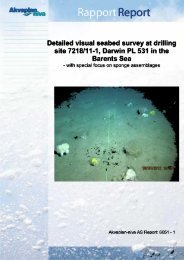A study of the priority substances of the Water Framework Directive ...
A study of the priority substances of the Water Framework Directive ...
A study of the priority substances of the Water Framework Directive ...
You also want an ePaper? Increase the reach of your titles
YUMPU automatically turns print PDFs into web optimized ePapers that Google loves.
..:::::::::: tributyltin compounds<br />
..:::72<br />
30 Tributyltin compounds<br />
� Tributyltin compounds (TBT) are mainly<br />
used for anti fouling on ships.<br />
� TBTs cause imposex in snails.<br />
� In Norway triphenyltin (TPhT) is monitored<br />
alongside with TBT.<br />
� Levels in <strong>the</strong> environment do not decrease<br />
substantially, and TBT monitoring should continue.<br />
Production and use<br />
TBTs have not been produced in Norway, but<br />
<strong>the</strong>y have to a large extent been used for anti<br />
fouling and wood preservation. There has been<br />
minor use in paint, disinfectants and detergents.<br />
The use <strong>of</strong> TBT and triphenyltin compounds<br />
(TPhT) is regulated. New use has been banned<br />
since 1990 on smaller boats and new use<br />
(import, export, production sales etc) is banned<br />
from 2003. All TBT anti fouling on ships is<br />
banned from 2008.<br />
Emissions, discharges,<br />
distribution and hot-spots<br />
Norwegian emissions <strong>of</strong> TBT have dropped<br />
from 58 tons in 1985 via 29 tons in 1995 to<br />
about 7 tons in 2003.<br />
Discharges to water were estimated to be 25<br />
tons in 1995 dropping to 15 tons in 2002, most<br />
discharges are considered to be to water as discharges<br />
are mainly from marinas and shipyards,<br />
but TBT may also leak from o<strong>the</strong>r products, or<br />
be released from plastics or wood. TBT wood<br />
preservatives are not included in <strong>the</strong> emission<br />
estimates, but <strong>the</strong> tonnage is not large. Removal<br />
<strong>of</strong> old anti fouling in marinas may cause new<br />
discharges.<br />
Monitoring<br />
Monitoring <strong>of</strong> TBT has been part JAMP and<br />
time trends exist here. TBT has also been investigated<br />
in several o<strong>the</strong>r studies (see references).<br />
Marine sediment<br />
Levels <strong>of</strong> TBT in marine sediments are very high<br />
in many fjords, harbours and shipyards.<br />
Marine biota<br />
Shellfish in harbours are highly contaminated all<br />
along <strong>the</strong> coast. Imposex is shown in half <strong>the</strong><br />
A <strong>study</strong> <strong>of</strong> <strong>the</strong> <strong>priority</strong> <strong>substances</strong> <strong>of</strong> <strong>the</strong> <strong>Water</strong> <strong>Framework</strong> <strong>Directive</strong><br />
TA-2140/2005<br />
FACTS<br />
Cas no.: 56-35-9<br />
Synonyms: TBT, Tributyltin oxide (TBTO), tributyltin fluoride<br />
(TBTF), biomet, butinox, C-Sn-9.<br />
Properties:<br />
Toxic effects: TBT is toxic to humans and very toxic to<br />
marine organisms. TBT also causes imposex in snails.<br />
Log Kow: 3,19 - 3,84<br />
Persistence: Half life in water (hydrolysis / volatilisation)<br />
for TBT is 11 months. By photodegradation, half<br />
life is more than 3 months. In water and sediment<br />
half life is 4 - 5 months (aerobic biodegradation) or 1<br />
- 3 months (anaerobic biodegradation) (CIRCA). In<br />
sediment, degradation may take years (HSDB). TBT<br />
compounds accumulate in organisms. BCF in Blue<br />
mussels (Mytilus edulis) is 10500.<br />
<strong>Water</strong> solubility: 0,1%<br />
Molecular formula: C 24 -H 54- Sn 2<br />
Metabolites: Hydroxy-tributyltin.<br />
investigated female snail population. Costal<br />
areas in Finnmark have lower levels than average.<br />
Fresh water biota<br />
Levels in burbot (Lota lota) liver in six lakes<br />
have been screened; concentrations are not very<br />
high compared to concentration in marine<br />
biota.<br />
Hotspots<br />
Marinas and shipyards are typical hotspots for<br />
TBT.<br />
Need for fur<strong>the</strong>r screening and monitoring<br />
There is no need for fur<strong>the</strong>r screening <strong>of</strong> TBT in<br />
Norway, but <strong>the</strong> use has been extensive and levels<br />
in <strong>the</strong> Norwegian marine environment are<br />
stable high and stable. Continued monitoring <strong>of</strong><br />
TBT is <strong>the</strong>refore necessary.<br />
Analysis<br />
Analysis <strong>of</strong> tributyltin is well developed and<br />
<strong>of</strong>ten part <strong>of</strong> packages with o<strong>the</strong>r organotin<br />
compounds.

















